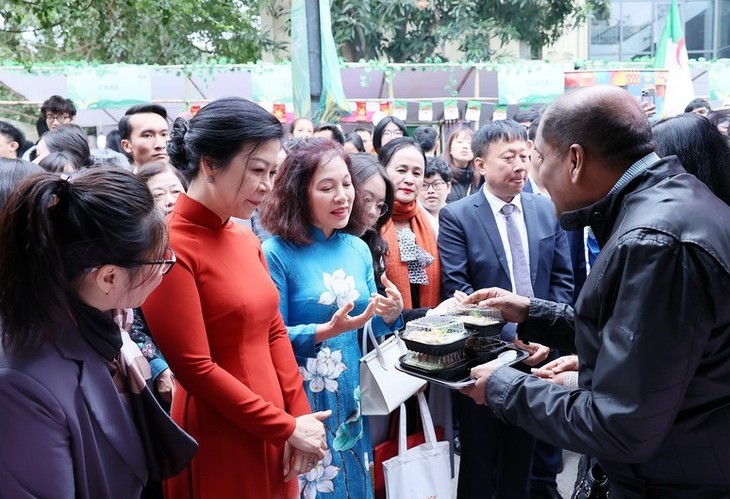(VOVWORLD) - The International Food Festival that ended at weekend in Hanoi provided a taste of the culinary diversity of participating countries and offered attendees an opportunity to experience the rich cultural traditions through food. The dishes stood out due to their emphasis on regional specialties, cultural significance, diverse offerings, interactive experiences, and the incorporation of local ingredients. These factors contributed to a unique culinary experience that celebrated both Vietnamese cuisine and global culinary diversity.
 Distinguished guests attend the opening ceremony of the International Food Festival 2024. (Photo: VNA) Distinguished guests attend the opening ceremony of the International Food Festival 2024. (Photo: VNA) |
Colorful, sweet-smelling, and eye-catching were what attendees at the International Food Festival 2024 thought of the food.
Organized by the Department of Diplomatic Corps Services of the Ministry of Foreign Affairs, the year-end festival, its 12th edition, has established itself as a prestigious annual event celebrated by the community of diplomatic missions and international organizations in Vietnam, explained Pauline Tamesis, United Nations Resident Coordinator in Vietnam.
“Food is essential in all societies. It is fuel for our bodies as well as a generator of jobs,” said Tamesis, adding, “But food functions are not limited to meeting biological needs. Cooking and gastronomy awaken artistic spirit and sharing meals is a means of social interaction and mixing different flavors is a way to connect cultures.”
Tamesis and other guests at the festival agreed that, from the aromatic spices of Southeast Asia to the savory dishes of Europe, this festival offered a world of culinary experiences.
The variety of dishes on show reflected the culinary diversity of the participating countries, said Shovgi Kamal Oglu Mehdizade, Azerbaijan’s Ambassador to Vietnam.
 At this year's festival, Azerbaijan brings lots of dishes to introduce Vietnamese people. (Photo: Bao Tram) At this year's festival, Azerbaijan brings lots of dishes to introduce Vietnamese people. (Photo: Bao Tram) |
He told VOV that this year Azerbaijan has prepared many dishes to represent its cuisine – sweets, meats, and vegetables.
“We have prepared Lula kebabs from beef and chicken, lamb kebab, doma which is very traditional Azerbaijani food, dovga, a very famous soup, and also many sweets, to introduce to our Vietnamese friends and citizens of Hanoi such beautiful and tasty food,” said Mr. Shovgi, adding, “We prepared more for the festival, with more varieties of food in our kitchen and with more Azerbaijani participation, to introduce our food to our Vietnamese friends.”
The Azerbaijani diplomat conclued that the festival is a very beautiful opportunity to learn about each other's culture, to share, and to develop. This is the best diplomacy.
Each festival booth told a unique cultural story through either food or other traditional products.
 In addition to some typical Iranian dishes, Iran’s booth attracts festival goers with its handicraft products. (Photo: Ha Tran) In addition to some typical Iranian dishes, Iran’s booth attracts festival goers with its handicraft products. (Photo: Ha Tran) |
Third secretary of the Islamic Republic of Iran to Vietnam Moslem Golestan said that at this year's event, Iran introduced some typical Iranian dishes including kabob koobideh, which is grilled lamb skewers, crispy rice made from rice, saffron and chicken, and a Persian yogurt drink called Doogh.
“In addition to those dishes, we also introduce some Iranian handicraft products, and Iranian saffron. The highlight of our booth this year is our handicrafts, which are very delicate and completely handmade. All the designs, images, and colors are hand-painted and hand-carved. That is why when Vietnamese people come to our stall, they all are surprised and attracted by our products.”
With the theme "Gastronomy of Unity," the festival emphasized food as a universal language that transcends cultural barriers.
 Dishes of Peru are displayed in an attractive maner. (Photo: Bao Tram) Dishes of Peru are displayed in an attractive maner. (Photo: Bao Tram) |
Many international dishes at the festival incorporated local Vietnamese ingredients, creating unique adaptations that reflect a blend of culinary traditions. This led to innovative flavors that differ from traditional preparations found in their countries of origin, said Fiorella Kristell Áviles Flores, Deputy Chief of Mission at the Peruvian Embassy in Vietnam.
“Actually, the dishes of the two countries are quite different. But despite these differences, we share a common point in preparing dishes. We use a lot of vegetables in the dishes, including banana leaves as a part of the service,” said Áviles Flores.
Each dish conveyed stories about the history and traditions of its country of origin. This storytelling aspect helps visitors gain deeper insights into the cultural significance behind each dish, enriching their understanding of global culinary practices.
 The 2024 international food festival is themed "Gastronomy of Unity". (Photo: Bao Tram) The 2024 international food festival is themed "Gastronomy of Unity". (Photo: Bao Tram) |
Echoing the point, Azerbaijani Ambassador Oglu Mehdizade, said, “In our cuisine, we like noodles, we have rice, we have meat, beef, and we like to make it very fresh. We like fresh food and also, we like to cook special foods for our holidays. And this is a great similarity in our cultures.”
Iranian diplomat Moslem Golestan said he thought the similarity between Iranian and Vietnamese cuisine is the way Iranians and Vietnamese people use spices in their dishes.
“In addition, some of our traditional drinks, I think, have similarities with Vietnamese cuisine,” Moslem Golestan added.

Festival goers can try various delicacies of participating countries like Saudi Arabia. (Photo: The Hanoi Times)
|
The International Food Festival 2024 was not just about food, it was also a platform for cultural diplomacy. It promoted the beauty of Vietnamese culture while highlighting the culinary traditions of other nations.
Beyond food tasting, it included engaging activities such as cooking demonstrations by professional chefs, a beer festival, and interactive experiences like "Food Passport" and "Cuisine on a Plate".